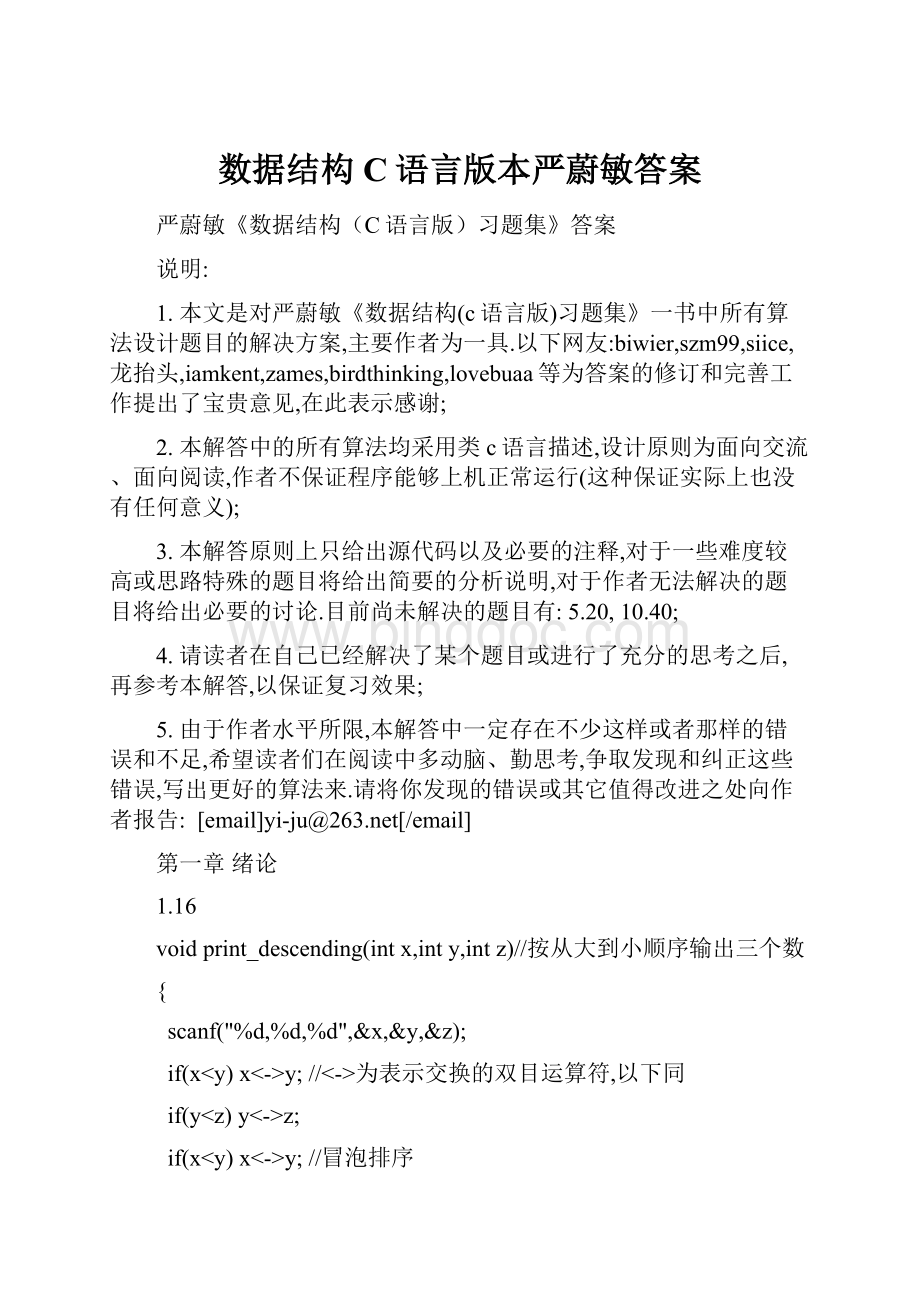数据结构C语言版本严蔚敏答案.docx
《数据结构C语言版本严蔚敏答案.docx》由会员分享,可在线阅读,更多相关《数据结构C语言版本严蔚敏答案.docx(204页珍藏版)》请在冰点文库上搜索。

数据结构C语言版本严蔚敏答案
严蔚敏《数据结构(C语言版)习题集》答案
说明:
1.本文是对严蔚敏《数据结构(c语言版)习题集》一书中所有算法设计题目的解决方案,主要作者为一具.以下网友:
biwier,szm99,siice,龙抬头,iamkent,zames,birdthinking,lovebuaa等为答案的修订和完善工作提出了宝贵意见,在此表示感谢;
2.本解答中的所有算法均采用类c语言描述,设计原则为面向交流、面向阅读,作者不保证程序能够上机正常运行(这种保证实际上也没有任何意义);
3.本解答原则上只给出源代码以及必要的注释,对于一些难度较高或思路特殊的题目将给出简要的分析说明,对于作者无法解决的题目将给出必要的讨论.目前尚未解决的题目有:
5.20,10.40;
4.请读者在自己已经解决了某个题目或进行了充分的思考之后,再参考本解答,以保证复习效果;
5.由于作者水平所限,本解答中一定存在不少这样或者那样的错误和不足,希望读者们在阅读中多动脑、勤思考,争取发现和纠正这些错误,写出更好的算法来.请将你发现的错误或其它值得改进之处向作者报告:
[email]yi-ju@[/email]
第一章绪论
1.16
voidprint_descending(intx,inty,intz)//按从大到小顺序输出三个数
{
scanf("%d,%d,%d",&x,&y,&z);
if(xy;//<->为表示交换的双目运算符,以下同
if(yz;
if(xy;//冒泡排序
printf("%d%d%d",x,y,z);
}//print_descending
1.17
Statusfib(intk,intm,int&f)//求k阶斐波那契序列的第m项的值f
{
inttempd;
if(k<2||m<0)returnERROR;
if(m elseif(m==k-1||m==k)f=1;
else
{
for(i=0;i<=k-2;i++)temp[i]=0;
temp[k-1]=1;temp[k]=1;//初始化
sum=1;
j=0;
for(i=k+1;i<=m;i++,j++)//求出序列第k至第m个元素的值
temp[i]=2*sum-temp[j];
f=temp[m];
}
returnOK;
}//fib
分析:
k阶斐波那契序列的第m项的值f[m]=f[m-1]+f[m-2]+......+f[m-k]
=f[m-1]+f[m-2]+......+f[m-k]+f[m-k-1]-f[m-k-1]
=2*f[m-1]-f[m-k-1]
所以上述算法的时间复杂度仅为O(m).如果采用递归设计,将达到O(k^m).即使采用暂存中间结果的方法,也将达到O(m^2).
1.18
typedefstruct{
char*sport;
enum{male,female}gender;
charschoolname;//校名为'A','B','C','D'或'E'
char*result;
intscore;
}resulttype;
typedefstruct{
intmalescore;
intfemalescore;
inttotalscore;
}scoretype;
voidsummary(resulttyperesult[])//求各校的男女总分和团体总分,假设结果已经储存在result[]数组中
{
scoretypescore[MAXSIZE];
i=0;
while(result[i].sport!
=NULL)
{
switch(result[i].schoolname)
{
case'A':
score[0].totalscore+=result[i].score;
if(result[i].gender==0)score[0].malescore+=result[i].score;
elsescore[0].femalescore+=result[i].score;
break;
case'B':
score[0].totalscore+=result[i].score;
if(result[i].gender==0)score[0].malescore+=result[i].score;
elsescore[0].femalescore+=result[i].score;
break;
…… …… ……
}
i++;
}
for(i=0;i<5;i++)
{
printf("School%d:
\n",i);
printf("Totalscoreofmale:
%d\n",score[i].malescore);
printf("Totalscoreoffemale:
%d\n",score[i].femalescore);
printf("Totalscoreofall:
%d\n\n",score[i].totalscore);
}
}//summary
1.19
Statusalgo119(inta[ARRSIZE])//求i!
*2^i序列的值且不超过maxint
{
last=1;
for(i=1;i<=ARRSIZE;i++)
{
a[i-1]=last*2*i;
if((a[i-1]/last)!
=(2*i))reurnOVERFLOW;
last=a[i-1];
returnOK;
}
}//algo119
分析:
当某一项的结果超过了maxint时,它除以前面一项的商会发生异常.
1.20
voidpolyvalue()
{
floattemp;
float*p=a;
printf("Inputnumberofterms:
");
scanf("%d",&n);
printf("Inputvalueofx:
");
scanf("%f",&x);
printf("Inputthe%dcoefficientsfroma0toa%d:
\n",n+1,n);
p=a;xp=1;sum=0;//xp用于存放x的i次方
for(i=0;i<=n;i++)
{
scanf("%f",&temp);
sum+=xp*(temp);
xp*=x;
}
printf("Valueis:
%f",sum);
}//polyvalue
第二章线性表
2.10
StatusDeleteK(SqList&a,inti,intk)//删除线性表a中第i个元素起的k个元素
{
if(i<1||k<0||i+k-1>a.length)returnINFEASIBLE;
for(count=1;i+count-1<=a.length-k;count++)//注意循环结束的条件
a.elem[i+count-1]=a.elem[i+count+k-1];
a.length-=k;
returnOK;
}//DeleteK
2.11
StatusInsert_SqList(SqList&va,intx)//把x插入递增有序表va中
{
if(va.length+1>va.listsize)returnERROR;
va.length++;
for(i=va.length-1;va.elem[i]>x&&i>=0;i--)
va.elem[i+1]=va.elem[i];
va.elem[i+1]=x;
returnOK;
}//Insert_SqList
2.12
intListComp(SqListA,SqListB)//比较字符表A和B,并用返回值表示结果,值为1,表示A>B;值为-1,表示A{
for(i=1;i<=A.length&&i<=B.length;i++)
if(A.elem[i]!
=B.elem[i])
returnA.elem[i]>B.elem[i]?
1:
-1;
if(A.length==B.length)return0;
returnA.length>B.length?
1:
-1; //当两个字符表可以互相比较的部分完全相同时,哪个较长,哪个就较大
}//ListComp
2.13
LNode*Locate(LinkListL,intx)//链表上的元素查找,返回指针
{
for(p=l->next;p&&p->data!
=x;p=p->next);
returnp;
}//Locate
2.14
intLength(LinkListL)//求链表的长度
{
for(k=0,p=L;p->next;p=p->next,k++);
returnk;
}//Length
2.15
voidListConcat(LinkListha,LinkListhb,LinkList&hc)//把链表hb接在ha后面形成链表hc
{
hc=ha;p=ha;
while(p->next)p=p->next;
p->next=hb;
}//ListConcat
2.16
见书后答案.
2.17
StatusInsert(LinkList&L,inti,intb)//在无头结点链表L的第i个元素之前插入元素b
{
p=L;q=(LinkList*)malloc(sizeof(LNode));
q.data=b;
if(i==1)
{
q.next=p;L=q;//插入在链表头部
}
else
{
while(--i>1)p=p->next;
q->next=p->next;p->next=q;//插入在第i个元素的位置
}
}//Insert
2.18
StatusDelete(LinkList&L,inti)//在无头结点链表L中删除第i个元素
{
if(i==1)L=L->next;//删除第一个元素
else
{
p=L;
while(--i>1)p=p->next;
p->next=p->next->next;//删除第i个元素
}
}//Delete
2.19
StatusDelete_Between(Linklist&L,intmink,intmaxk)//删除元素递增排列的链表L中值大于mink且小于maxk的所有元素
{
p=L;
while(p->next->data<=mink)p=p->next;//p是最后一个不大于mink的元素
if(p->next) //如果还有比mink更大的元素
{
q=p->next;
while(q->datanext;//q是第一个不小于maxk的元素
p->next=q;
}
}//Delete_Between
2.20
StatusDelete_Equal(Linklist&L)//删除元素递增排列的链表L中所有值相同的元素
{
p=L->next;q=p->next;//p,q指向相邻两元素
while(p->next)
{
if(p->data!
=q->data)
{
p=p->next;q=p->next;//当相邻两元素不相等时,p,q都向后推一步
}
else
{
while(q->data==p->data)
{
free(q);
q=q->next;
}
p->next=q;p=q;q=p->next;//当相邻元素相等时删除多余元素
}//else
}//while
}//Delete_Equal
2.21
voidreverse(SqList&A)//顺序表的就地逆置
{
for(i=1,j=A.length;i A.elem[i]<->A.elem[j];
}//reverse
2.22
voidLinkList_reverse(Linklist&L)//链表的就地逆置;为简化算法,假设表长大于2
{
p=L->next;q=p->next;s=q->next;p->next=NULL;
while(s->next)
{
q->next=p;p=q;
q=s;s=s->next;//把L的元素逐个插入新表表头
}
q->next=p;s->next=q;L->next=s;
}//LinkList_reverse
分析:
本算法的思想是,逐个地把L的当前元素q插入新的链表头部,p为新表表头.
2.23
voidmerge1(LinkList&A,LinkList&B,LinkList&C)//把链表A和B合并为C,A和B的元素间隔排列,且使用原存储空间
{
p=A->next;q=B->next;C=A;
while(p&&q)
{
s=p->next;p->next=q;//将B的元素插入
if(s)
{
t=q->next;q->next=s;//如A非空,将A的元素插入
}
p=s;q=t;
}//while
}//merge1
2.24
voidreverse_merge(LinkList&A,LinkList&B,LinkList&C)//把元素递增排列的链表A和B合并为C,且C中元素递减排列,使用原空间
{
pa=A->next;pb=B->next;pre=NULL;//pa和pb分别指向A,B的当前元素
while(pa||pb)
{
if(pa->datadata||!
pb)
{
pc=pa;q=pa->next;pa->next=pre;pa=q;//将A的元素插入新表
}
else
{
pc=pb;q=pb->next;pb->next=pre;pb=q;//将B的元素插入新表
}
pre=pc;
}
C=A;A->next=pc;//构造新表头
}//reverse_merge
分析:
本算法的思想是,按从小到大的顺序依次把A和B的元素插入新表的头部pc处,最后处理A或B的剩余元素.
2.25
voidSqList_Intersect(SqListA,SqListB,SqList&C)//求元素递增排列的线性表A和B的元素的交集并存入C中
{
i=1;j=1;k=0;
while(A.elem[i]&&B.elem[j])
{
if(A.elem[i] if(A.elem[i]>B.elem[j])j++;
if(A.elem[i]==B.elem[j])
{
C.elem[++k]=A.elem[i];//当发现了一个在A,B中都存在的元素,
i++;j++;//就添加到C中
}
}//while
}//SqList_Intersect
2.26
voidLinkList_Intersect(LinkListA,LinkListB,LinkList&C)//在链表结构上重做上题
{
p=A->next;q=B->next;
pc=(LNode*)malloc(sizeof(LNode));
C=pc;
while(p&&q)
{
if(p->datadata)p=p->next;
elseif(p->data>q->data)q=q->next;
else
{
s=(LNode*)malloc(sizeof(LNode));
s->data=p->data;
pc->next=s;pc=s;
p=p->next;q=q->next;
}
}//while
}//LinkList_Intersect
2.27
voidSqList_Intersect_True(SqList&A,SqListB)//求元素递增排列的线性表A和B的元素的交集并存回A中
{
i=1;j=1;k=0;
while(A.elem[i]&&B.elem[j])
{
if(A.elem[i] elseif(A.elem[i]>B.elem[j])j++;
elseif(A.elem[i]!
=A.elem[k])
{
A.elem[++k]=A.elem[i];//当发现了一个在A,B中都存在的元素
i++;j++;//且C中没有,就添加到C中
}
else{i++;j++;}
}//while
while(A.elem[k])A.elem[k++]=0;
}//SqList_Intersect_True
2.28
voidLinkList_Intersect_True(LinkList&A,LinkListB)//在链表结构上重做上题
{
p=A->next;q=B->next;pc=A;
while(p&&q)
{
if(p->datadata)p=p->next;
elseif(p->data>q->data)q=q->next;
elseif(p->data!
=pc->data)
{
pc=pc->next;
pc->data=p->data;
p=p->next;q=q->next;
}
}//while
}//LinkList_Intersect_True
2.29
voidSqList_Intersect_Delete(SqList&A,SqListB,SqListC)
{
i=0;j=0;k=0;m=0; //i指示A中元素原来的位置,m为移动后的位置
while(i {
if(B.elem[j] elseif(B.elem[j]>C.elem[k])k++;
else
{
same=B.elem[j]; //找到了相同元素same
while(B.elem[j]==same)j++;
while(C.elem[k]==same)k++; //j,k后移到新的元素
while(i A.elem[m++]=A.elem[i++]; //需保留的元素移动到新位置
while(i }
}//while
while(i A.elem[m++]=A.elem[i++]; //A的剩余元素重新存储。
A.length=m;
}//SqList_Intersect_Delete
分析:
先从B和C中找出共有元素,记为same,再在A中从当前位置开始,凡小于same的
元素均保留(存到新的位置),等于same的就跳过,到大于same时就再找下一个same.
2.30
voidLinkList_Intersect_Delete(LinkList&A,LinkListB,LinkListC)//在链表结构上重做上题
{
p=B->next;q=C->next;r=A-next;
while(p&&q&&r)
{
if(p->datadata)p=p->next;
elseif(p->data>q->data)q=q->next;
else
{
u=p->data;//确定待删除元素u
while(r->next->datanext;//确定最后一个小于u的元素指针r
if(r->next->data==u)
{
s=r->next;
while(s->data==u)
{
t=s;s=s->next;free(t);//确定第一个大于u的元素指针s
}//while
r->next=s;//删除r和s之间的元素
}//if
while(p->data=u)p=p->next;
while(q->data=u)q=q->next;